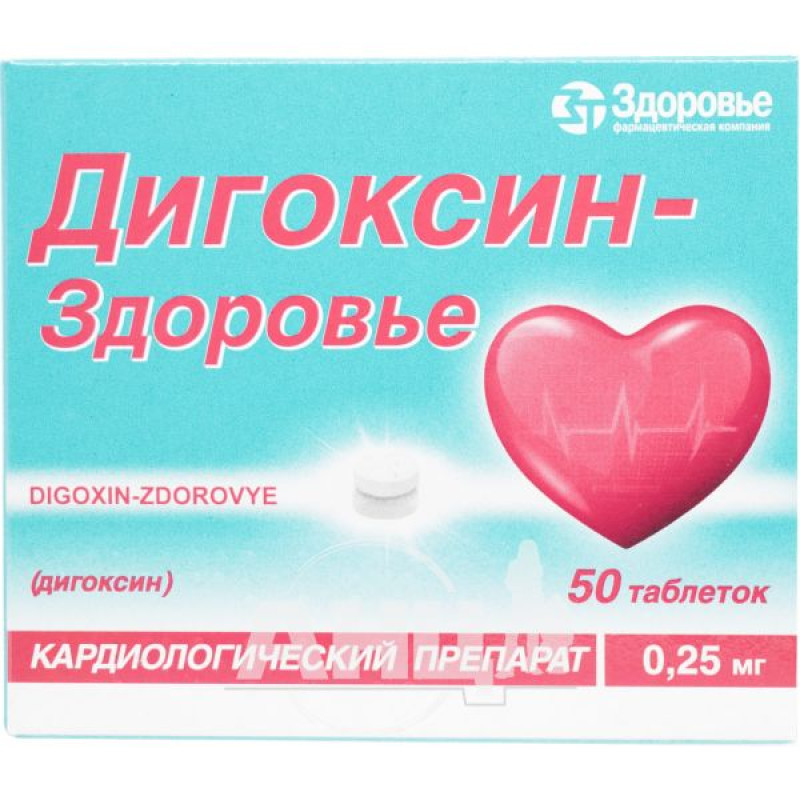Digoxin-Health tablets 0.25 mg blister No. 50

"Digoxin-Health" tablets are used for the following indications: congestive heart failure, atrial fibrillation and flutter (to regulate heart rate), supraventricular paroxysmal tachycardia.
Composition
The active substance is digoxin (one tablet contains 0.25 mg of digoxin).
Excipients: refined sugar; potato starch; glucose monohydrate; mineral oil; talc; calcium stearate.
Contraindication
hypersensitivity to the components of the drug / other cardiac glycosides; intoxication with previously used digitalis drugs; arrhythmias caused by glycoside intoxication in history; pronounced sinus bradycardia, AV block II-III degree, Morgagni-Adams-Stokes syndrome; carotid sinus syndrome; hypertrophic obstructive cardiomyopathy; supraventricular arrhythmias associated with additional AV conduction pathways, including Wolff-Parkinson-White syndrome; ventricular paroxysmal tachycardia / ventricular fibrillation; thoracic aortic aneurysm; hypertrophic subaortic stenosis; isolated mitral stenosis; endocarditis, myocarditis, unstable angina, acute myocardial infarction, constrictive pericarditis, cardiac tamponade; hypercalcemia, hypokalemia.Method of application
Take orally, without chewing, with 150-200 ml of water. It is recommended to use between meals.
Doses are set individually.
Adults and children aged 10 and over
For rapid digitalization, prescribe 0.5-1 mg (2-4 tablets), then every 6 hours 0.25-0.75 mg (1-3 tablets) for 2-3 days; after the patient's condition improves, transfer to a maintenance dose of 0.125-0.5 mg per day in 1-2 doses.
For slow digitalization, immediately prescribe a maintenance dose of 0.125-0.5 mg per day in 1-2 doses; saturation in this case occurs approximately one week after the start of therapy.
The highest daily dose for adults is 1.5 mg (6 tablets).
Children
The dose of the drug for children should be determined taking into account the selected digitalization regimen, the child's age and body weight.
Children aged 2 years and older for rapid digitalization should be prescribed a daily dose of 0.03-0.06 mg/kg of body weight. For slow digitalization, use a dose that is ¼ of the dose for rapid saturation.
The maximum daily loading dose is 0.75-1.5 mg, the maximum daily maintenance dose is 0.125-0.5 mg.
For children, the loading dose should be administered in divided doses: approximately half of the total dose for the first dose, followed by the remainder of the total dose in divided doses at 4-8 hour intervals, with clinical response assessed before each subsequent dose. If the patient's clinical response requires a change in the previously calculated loading dose, the maintenance dose is calculated based on the actual loading dose received.
If it is necessary to use digoxin in a dose of 0.125 mg, a drug with the possibility of such a dosage should be used.
Application features
Pregnant women
There is no information on the possibility of teratogenic effects of digoxin. It should be borne in mind that digoxin penetrates the placenta, clearance increases during pregnancy. During pregnancy, the drug can be used under the supervision of a physician only when the expected benefit to the mother outweighs the potential risk to the fetus.
Digoxin passes into breast milk in amounts that do not adversely affect the child (the concentration of digoxin in breast milk is 0.6-0.9% of the concentration in the mother's blood plasma). When using digoxin, breastfeeding women should monitor the child's heart rate.
Drivers
Until the individual reaction to the drug is determined, it is necessary to refrain from driving vehicles and other mechanisms due to the possibility of adverse reactions from the nervous system and organs of vision.
Overdose
Symptoms:
Cardiovascular system: arrhythmias, including bradycardia, AV block, ventricular tachycardia or extrasystole, ventricular fibrillation; gastrointestinal tract: anorexia, nausea, vomiting, diarrhea; central nervous system and sensory organs: headache, fatigue, dizziness.The most dangerous symptoms are rhythm disturbances due to the risk of death from the development of ventricular arrhythmias or heart block with asystole.
Treatment: gastric lavage, administration of activated charcoal, colestipol or cholestyramine.
Side effects
Blood and lymphatic system: eosinophilia, thrombocytopenia, agranulocytosis.
Immune system: hypersensitivity reactions, including itching, flushing, rash, including erythematous, papular, maculopapular, vesicular; urticaria, angioedema.
Endocrine system: digoxin has estrogenic activity, so gynecomastia in men is possible with prolonged use.
Mental disorders: disorientation, confusion, amnesia, depression, acute psychosis, delusions, visual and auditory hallucinations, especially in elderly patients, seizures.
Nervous system: headache, neuralgia, fatigue, weakness, dizziness, drowsiness, bad dreams, anxiety, nervousness, agitation, apathy.
Cardiovascular system: rhythm and conduction disorders (sinus bradycardia, sinoatrial block, monofocal or multifocal extrasystoles (especially bigeminia, trigeminia), PR interval prolongation, ST segment depression, AV block, paroxysmal atrial tachycardia, ventricular fibrillation, ventricular arrhythmia), development or worsening of heart failure. These disorders may be early signs of excessive doses of digoxin.
Digestive tract: anorexia, nausea, vomiting, abdominal pain, diarrhea, especially in elderly patients; impaired visceral circulation, ischemia and necrosis of the intestine.
Adverse reactions to digoxin are dose-related and usually occur at doses greater than those required to achieve a therapeutic effect. Doses should be carefully selected and adjusted according to the clinical condition of the patient.
Storage conditions
Store in the original packaging at a temperature not exceeding 25 °C, out of the reach of children.
Shelf life - 5 years.
There are no reviews for this product.
There are no reviews for this product, be the first to leave your review.
No questions about this product, be the first and ask your question.




